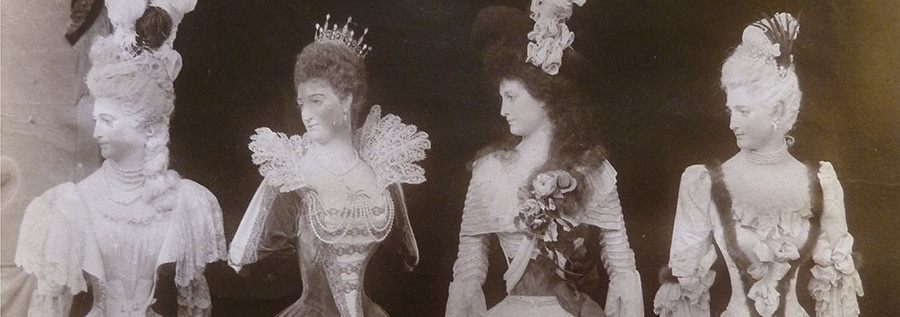Meet the Hewitts: Part Five sketched the active lifestyle at the Hewitt country home, Ringwood Manor. This month, April, will focus on Paris (of course) and explore how the sisters planned a museum for Cooper Union.
Margery Masinter, Trustee, Cooper-Hewitt, National Design Museum
Sue Shutte, Historian at Ringwood Manor
The Sisters Form a Plan: Paris, 1890’s
The establishment of a museum for the arts of decoration at Cooper Union was first reported in the 1895 Cooper Union Annual Report. In this report, Amy, Sarah, and Eleanor were acknowledged for their years of planning and collecting exhibits for the new teaching museum, which was inspired by the Musée des Arts Décoratifs in Paris (part of Union Centrale des Arts Décoratifs, or UCAD).
At some point, during their annual visits to Europe, the sisters spent time with the directors of the Musée des Arts in Paris, who advised them about the organization and collection of objects for their venture. Unfortunately no letters or documents in their archives have been found concerning the Hewitt family, and there are no relevant letters, diaries, or photographs from 1890 to 1895 in the Smithsonian or Cooper Union Archives. The documents that we do have are Eleanor and Sarah’s personal scrapbooks and notes, Cooper Union reports, and news articles from 1897. The images below provide a glimpse into the Hewitts’ scrapbooks filled with news articles, many in French, about what was going on in Paris, London, Vienna, and Russia, and articles about major collections, titled collectors, art exhibitions, auction prices, etc., all revealing their keen interest in European arts and current events.

Hewitt Sisters scrapbook cover and sampling of news articles. Courtesy of Cooper Union Library.
In 1892, the UCAD mounted a large exhibition of women’s work at the Palais de l’Industrie, which at that time housed the collections of the Musée des Art. The Palais de l’Industrie was an enormous exhibition hall built for the Paris World Fair in 1855. Let’s imagine that the Hewitt sisters would have strolled the immense galleries taking note of the high quality of decorative arts on exhibit. The images below, from the Paris Bibliotheque archive scrapbooks, give an idea of what they were looking at.

Palais de l’Industrie. Watercolor, 1892. Courtesy of Bibliotheque des Arts Décoratifs, UCAD Archive, Paris.

Exposition Catalogue cover by Eugene Grasset, Les Arts de la Femme, 1892. Courtesy of Bibliotheque des Arts Décoratifs, UCAD Archive, Paris.
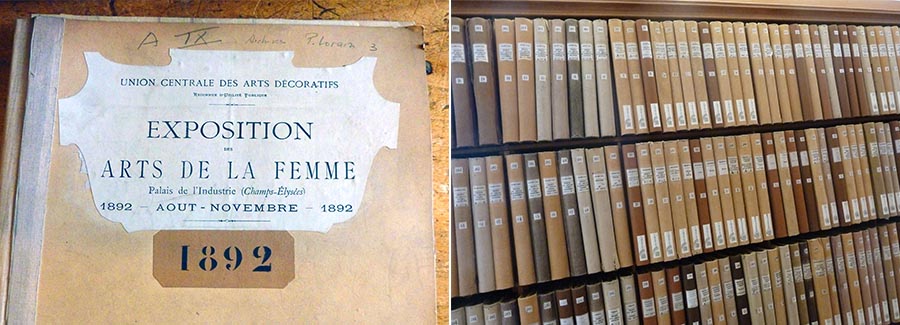
Scrapbook, introductory page, 1892 and current view of shelves of scrapbooks at the Bibliotheque. Courtesy of Bibliotheque des Arts Décoratifs, UCAD Archive, Paris.
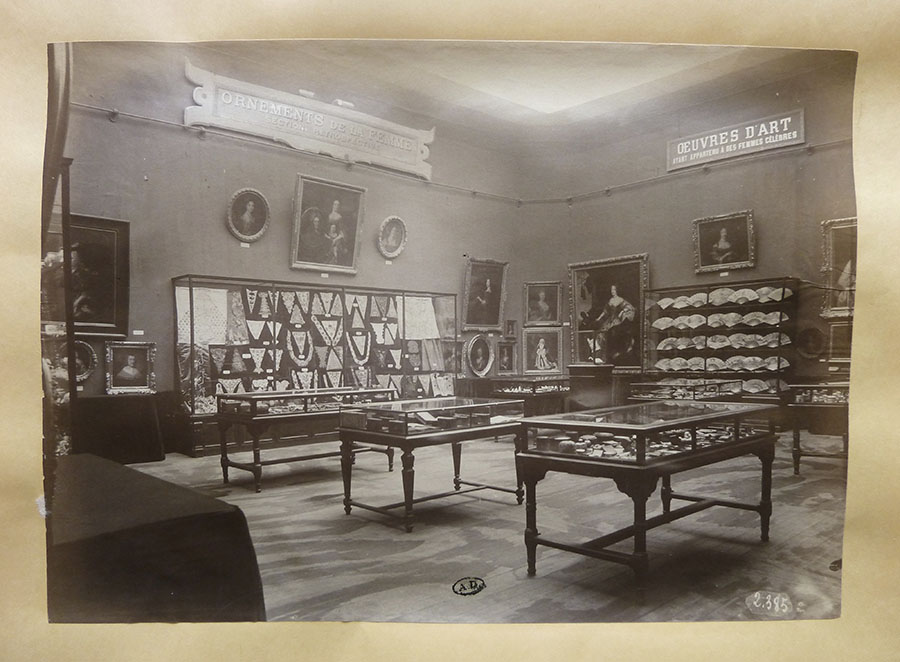
Photograph, “Ornaments de la femme,” 1892. Courtesy of Bibliotheque des Arts Décoratifs, UCAD Archive, Paris.
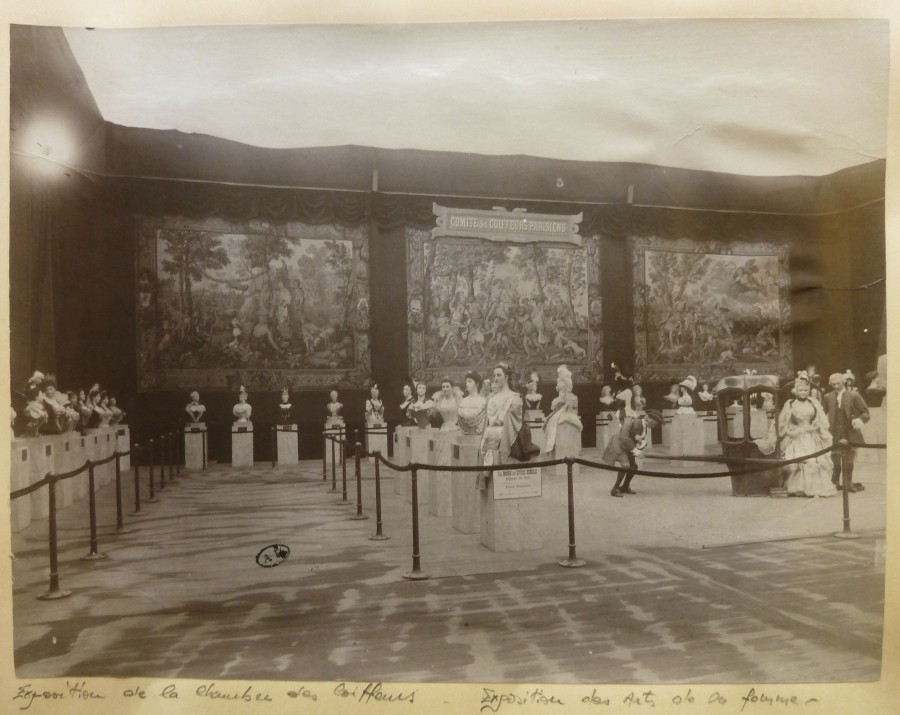
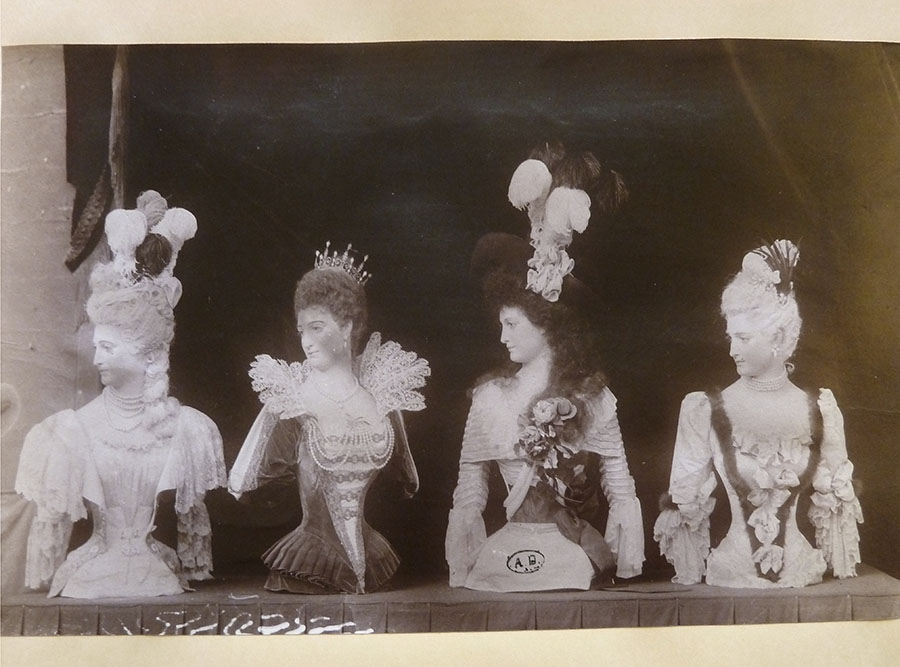
Photographs, “Comité des Coiffeurs Parisiens,” 1892. Courtesy of Bibliotheque des Arts Décoratifs, UCAD Archive, Paris.
Let’s continue to imagine that the young Hewitt women wore the latest in Parisian fashion for their visits to museums, collectors, dealers, and exhibitions. In 1892, Sarah was 33, and Eleanor was 29. Amy, 36, was married, and lived in Paris. Regrettably, there are no photographs of them at this time. The elegant jackets pictured below were from their collection, willed by Sarah to her niece, the Princess Viggo (Amy’s daughter, Eleanor).
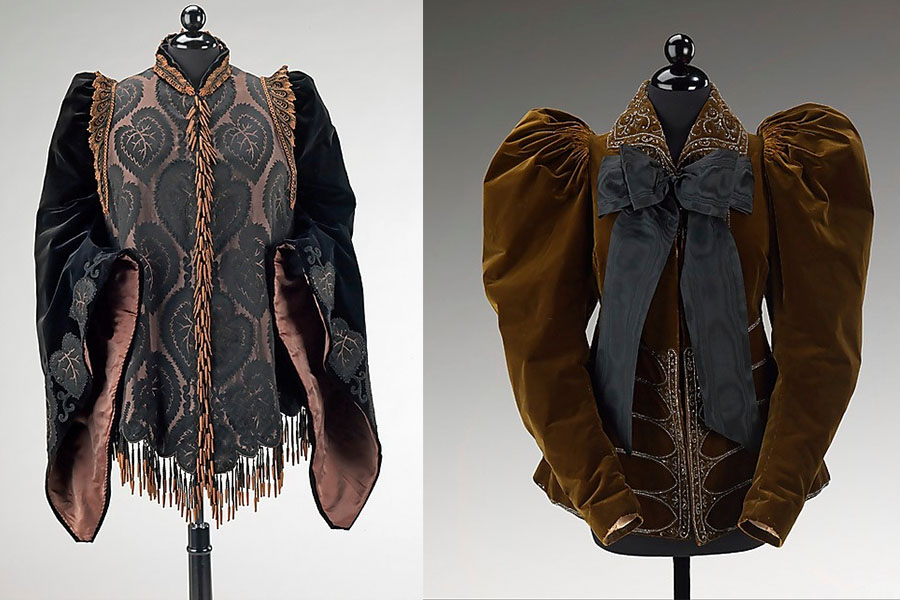
Left: Afternoon jacket, designed by Emile Pingat, Paris, ca. 1890. Right: Afternoon jacket, designed by House of Worth, Paris, ca. 1895. Courtesy of the Metropolitan Museum of Art Costume Institute. Gift of the Princess Viggo.
Were the sisters aware of the UCAD organization called Patronage des Dames? Drawn from the ranks of the “rich elite,” this group of women were given the task of enriching the collections of the Musée des Arts and library. Again, it’s a guess that they would have been. Another women’s philanthropic group, the Comité des Dames, was founded by the Musée in 1895 to encourage and support women working in the decorative arts.
There’s a parallel between the Comité des Dames in Paris, the Ladies Advisory Council to the Women’s Art School at Cooper Union and other women’s philanthropic and cultural organizations and schools supporting women in the arts for industry. The Chicago World’s Fair of 1893 provided an opportunity for artists, industrialists and philanthropists from many countries to meet and share visions.
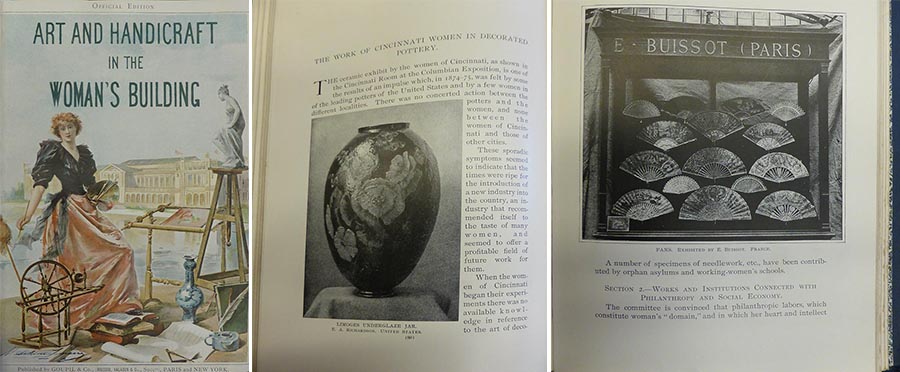
Catalog cover and pages from Art and Handicraft in the Woman’s Building of the Worlds Columbian Exposition, 1893. Courtesy of Cooper-Hewitt, National Design Museum Library.
The Chicago World’s Fair (Columbian Exposition) in 1893 was an international social and cultural event. There is no doubt that the Hewitt family attended. Candace Wheeler, textile designer and founder of the Society of Decorative Art in New York, designed the interior of the Women’s Building, which showcased exhibitions of applied arts, including textiles, wallpapers, book arts, architectural renderings, and more from women’s groups around the world. The implications for women’s employment in the applied art industry took a major step forward. The displays by American women producing designs for American manufacturers would have had a major impact on the Hewitt sisters, and the need for a public museum at Cooper Union to inspire good design became their priority. Their grandfather Peter Cooper had always envisioned some kind of exhibition space within Cooper Union, and they believed that a museum of decorative arts would fulfill his dream.
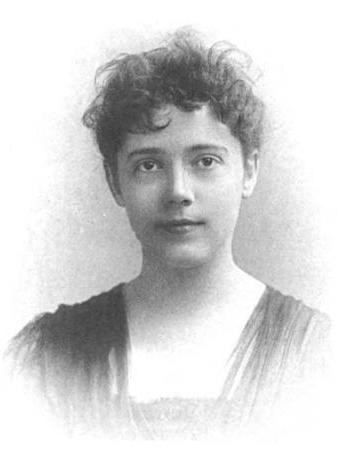
Image of Elizabeth Bisland, journalist and author of Proposed Plan of the Cooper Union Museum for the Arts of Decoration, 1896
Elizabeth Bisland (Mrs. Charles Wetmore, 1861-1929) was a respected journalist and good friend of the Hewitt sisters. She wrote a defining document in 1896 titled Proposed Plan of the Cooper Union Museum for the Arts of Decoration. After acknowledging the assistance and advice of the Musée des Arts to the Hewitt sisters, Bisland detailed the organization and content of the new museum, emphasizing the need for “collecting beautiful specimens of art applied to industry” in order to encourage and inspire American industry to elevate the public taste. This document preceded the formal announcement of the opening of the museum in 1897.
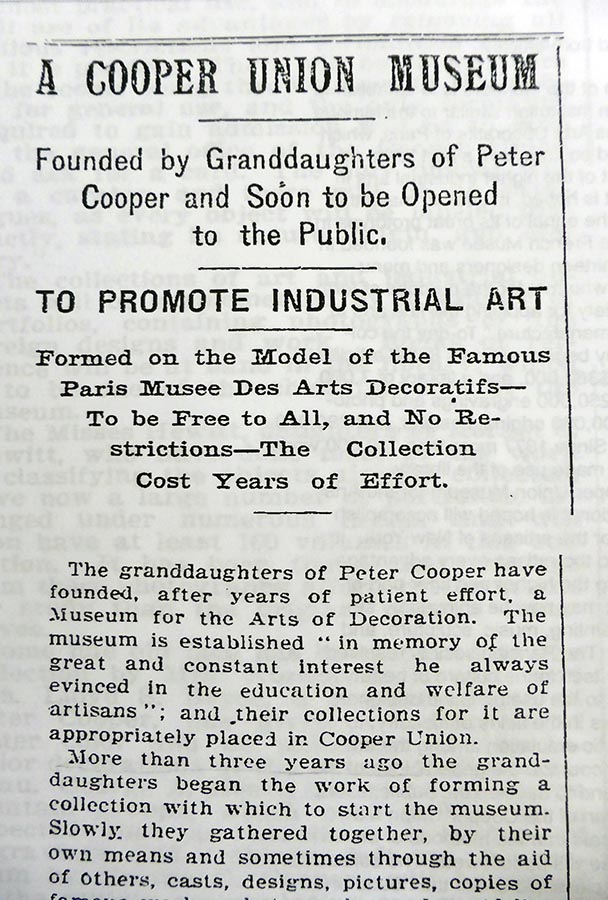
New York Times article, May 23, 1897.
In May 1897, the Museum located on the fourth floor of Cooper Union was officially inaugurated. Its collections consisted of gifts from friends and family of textiles, decorative engravings, etchings, furniture and books, as well as more than 300 plaster casts made by the Musée des Arts Décoratifs from historic originals in its collection. The casts were a gift from their supportive parents, Abram and Amelia Hewitt.
The New-York Tribune, May 24, 1897, attributes the museum founding to “the two granddaughters of Peter Cooper, Miss Eleanor and Miss Sarah Hewitt. . . . ‘Of course, it is only a beginning (said Miss Hewitt). The collection is not large, but is well selected . . . and we hope it will steadily increase.'” While Amy played a major role in the planning and remained a generous donor to the Museum, it was Eleanor and Sarah that devotedly gave life to it, as will be seen in the upcoming “snippets.”
An Interactive Timeline of the Cooper Hewitt World
Full timeline is available here.
Sources:
Bibliotheque des Arts Décoratifs, Le Comité des Dames, exhibition, 2012. Online at www.bibliothequedesartsdecoratifs.fr Expositions, Archives, Le Comité des Dames.
Bisland, Elizabeth. Proposed Plan of the Cooper Union Museum for the Arts of Decoration, 1896. Online at https://archive.org/details/proposedplanofco00bisl
Guillemette Delaporte, Director of the Bibliotheque des Arts Décoratifs, Paris, November 2012. A conversation about the UCAD Archive.
Coming Up Next Month:
Cooper Union Museum: Early years of “Fairy Godmothers and Miracles”
